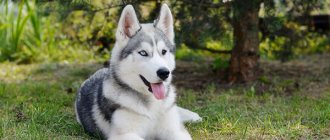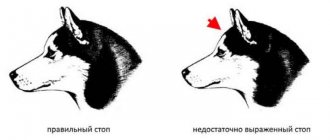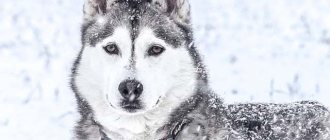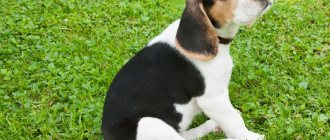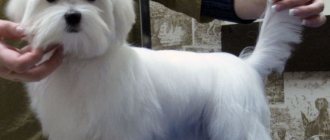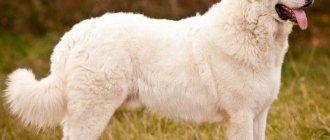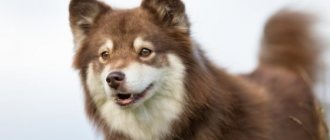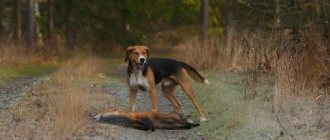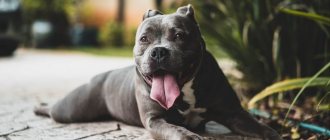It is thanks to its beautiful exterior that many people want to get such a pet, but there is no need to rush.
Representatives of this breed have a rather complex character, so before buying a puppy you should read the description of the breed and reviews of the owners in order to have an idea of the breed as a whole and evaluate your strengths.
Character and behavior
These dogs are distinguished by their peacefulness and friendliness. They enjoy the company of dogs, people, and the attention of their owner and family. However, like all northern breeds, they are prone to dominance, willfulness and stubbornness. Huskies prefer to be free, although they unquestioningly obey the owner who can prove his leadership.
Animals are very active and need constant training. If the pet does not splash out energy, then it becomes destructive. In the family they behave like perky family dogs, always ready to help. They treat their owner with trepidation and cannot tolerate long separations.
Attitude towards children
Even in the far north, it was customary to get a Husky when a baby was born in the house. It was believed that every child should have a dog.
The animals not only served as working dogs. They were nannies, toys, hot water bottles. In severe frosts, all the pets were gathered in a room to keep the children warm.
Huskies treat children of different ages with trepidation, play with them, and take care of them. They will protect babies from danger. The dog is considered a family dog, so it is suitable even for couples with newborns . Any angry or aggressive behavior is not observed among representatives of the breed.
Pros and cons of keeping a husky in an enclosure
Statistically, kennel dogs:
- healthier: they are less likely to experience osteopathic problems, allergies, and respiratory system diseases;
- better “dressed”: they do not shed all year round, they have denser and more beautiful coat.
Keeping a husky outdoors also solves the problem of cleaning, which must be done daily (and during the molting period, several times a day) by owners whose dogs live in their homes.
There are also difficulties:
- an enclosure dog is not constantly near the owner, like an apartment dog, so you need to allocate a lot of free time to communicate with it;
- building an enclosure that is suitable for the size and functionality of a husky requires effort, money and time.
You should not place a husky in an outdoor enclosure with the expectation that the dog will guard the house and property. This is unlikely. Northern sled dogs can, under favorable circumstances, display protective qualities, considering the territory of the yard to be their own. Take this as a pleasant bonus, without particularly counting on your pet: huskies are not guard dogs. A representative of any service breed will perform a guard function much better.
You can equip an outdoor enclosure for your husky if you are guided by the desire to give your dog a long, healthy life in the fresh air. At the same time, you need to be aware that such an animal will need perhaps even more attention than a domestic animal. In any case, in an apartment you can show your pet your love while going about your business (for example, petting it and watching TV at the same time). The time spent together with the enclosure dog should belong entirely to her.
Content
Sled dogs with incredibly beautiful blue eyes are popular today. They are adopted without thinking about the consequences, although it is a bit cramped for a dog in a city apartment.
Need for physical activity
Sled dogs need activity by default. Huskies require a minimum of three and a half hours of active walking per day. She needs to visit new places, explore routes and do physical work that requires endurance.
To throw out the husky's accumulated energy, harness the dog to a sled - it will be happy to give the kids rides.
Representatives of the breed tend to run away - they can break off a leash, break through a window glass or dig a hole under a fence. There are known cases when a husky ran away from its owner simply by smelling a herd of grazing sheep nearby and wanting to get to know them.
The duration of walking pregnant huskies should be at least 20 minutes, 4 times a day. Nursing bitches need to be walked three times a day - 2 times for 10 minutes and 1 time for 20-25 minutes.
Siberian Husky: character, description, photos, puppies, prices
Appearance care
Caring for a husky is easy - its coat is self-cleaning. Even after rolling around in the mud, the dog will look well-groomed and shiny. The Siberian beauty should be bathed no more than once a year, and brushed twice a year. To effectively remove undercoat, use a furminator - it combs out the fur perfectly, while cutting off stray hairs.
In addition to the fur, take care of your dog’s claws and paws - in winter, lubricate the pads with protective wax, and trim the claws with a nail clipper.
Nutrition
Husky is the only dog that can eat fatty pork without harming its liver. If the diets of other breeds are based on a combination of proteins and carbohydrates, then the nutrition of a husky is based on a balance of fats and proteins. Decide what you will feed your dog - ready-made food or natural products. Choose food with the highest fat content possible. Do not believe the “premium class” labels and carefully study the components of the product.
By eating dry food, the dog deprives the body of fluids, so water should be available to it at any time of the day. If you notice that your husky doesn't drink much, feed it pellets soaked in water.
Natural food is of higher quality than sublimates.
However, you will have to consider a balanced diet of the following foods:
- meat;
- buckwheat;
- rice;
- carrot;
- cucumber;
- sea fish.
Do not feed your dog bones or minced meat. Cut pork or beef into large pieces to ensure your Husky's digestion.
Puppies are fed according to a special regime, and after a year, huskies are completely transferred to “adult” food.
Caring for Siberian Huskies
It should be remembered that this breed is very active and needs space.
Such a dog will prefer to spend most of its time frolicking in the fresh air, chasing a ball or a stick. If you take a husky into an apartment and do not devote enough time to walking, not only will it start to get blues, but it is also fraught with joint diseases. Don't forget - huskies love attention. Especially with puppies you need an eye and an eye. Don’t leave them alone in the apartment for a long time if you don’t want to see the chewed upholstery of the sofa, shoes and even the entrance doors when you arrive. Therefore, always remember that the dog needs to be occupied with something, interested in something, or simply be close to it and communicate.
https://www.youtube.com/watch?v=ytcreators
Each breed has its own specific rules and care features. Let's take a closer look at the basic rules for caring for a husky:
- The dog sheds twice a year and quite heavily, a brush is your best friend, do not forget to brush your pet.
- Due to his activity, the dog can get very dirty during a walk, make sure that he does not bring dirt into your house.
- If a husky lives in an apartment, it is recommended to trim his nails, as he does not grind them down enough on the ground and can scratch his owners.
There are no significant differences in care, but do not forget to constantly monitor the cleanliness of the enclosure and ensure that your pet does not drag foreign objects into it that could injure itself.
The crate (with thick, strong bars) in which your dog may be kept should also remain clean. It's also important to make sure your dog has plenty of his favorite toys in case you lock him up.
Your pet's kennel should be cleaned at least once a day. For the cold season it can be insulated with additional blankets or rugs, and for the summer it can be lightened. Teach your dog that you are not trying to claim his home, but just want to help him and put things in order. Otherwise, every time you clean the booth, it may be accompanied by a disapproving growl from the owner.
For such a dog, the best option would be a good, strong collar made of leather or coarsely woven threads, since during walks it can jerk violently, and both the dog and the leash will slip out of your hands. Watch the size - it should not rub your neck. It is not recommended to put a strict, metal collar on a husky, as it can damage its skin or cause more serious injuries due to its restless nature.
An electric collar, which is often used for training, is not entirely suitable in this situation. However, if your dog is too willful, tends to run away from you and disobey - and this often happens, you can try this method. The main thing is to be extremely careful and not develop excessive fearfulness in the dog.
Leash
When walking with your pet, you should choose a leash that, first of all, will not break. Thin chains, ropes or laces will not work; a husky's jerk from a standstill is 60–70 kilograms, so this version of the leash will break at the first opportunity. Choose carefully a leash that is long enough and strong enough.
Walking harness
If you follow the previous tips, choosing a harness for walking will not be difficult. This option is more effective than a leash, especially if your dog cannot resist the temptation to rush to his favorite park. A pet harness is more comfortable and easier to control, since it does not pull the dog’s neck, but secures it under the chest on all four paws. Therefore, choose a harness made of non-chafing and non-synthetic materials and, most importantly, the size for your pet.
READ Is it possible to give chicken necks to cats how to give chicken bones
Muzzle
The first problem you will encounter is the dog’s terrible protest against such a restriction of his freedom. It will take a long time to accustom him to a muzzle, watching sad eyes and attempts to pull it off his muzzle with his paws. In this case, choose a nylon or leather muzzle - with a metal one, the dog can damage both its muzzle and paws. Moreover, a fabric muzzle will be easier to carry and put on/remove from the dog when necessary.
They feel good in an apartment and easily adapt even to the conditions of a cramped apartment; the main problem is the need for active long walks and physical activity.
Dogs of this breed need at least 2 hours of active walks, this includes playing with other dogs, training, running in open areas (in a field, park).
It should be remembered that dogs are quite active and tend to explore the area, so you need to walk them on a leash.
When keeping a husky in an apartment, an unpleasant moment can be shedding, which lasts for 3 weeks and happens twice a year. During the molting period, they completely lose their undercoat. The rest of the time, hair loss is insignificant and does not cause trouble. It is noteworthy that when kept in a warm climate, where there is no sharp change in seasons, huskies gradually shed all year round. To reduce dirt during shedding, it is recommended to comb the coat from time to time.
Keeping a Siberian Husky in an apartment is also difficult because the dog loves to chew. There must be toys for these purposes. Puppies are inquisitive and playful, dragging into their mouths everything that comes their way, for example, shoes, which in apartments are always in sight and in an accessible place. But even energetic adult dogs, deprived of intense stress, can destroy the entire apartment, chew furniture, cords and other objects that are accessible and pleasant to the teeth.
When keeping a husky in an apartment, he is given a cool place, for example in a hallway with a tiled floor. But the animal should not lie on the bare floor, because... it is too hard and as a result bedsores can form, for example on the elbows. It is best to construct a wooden platform located 20-30 cm from the floor or purchase a special mattress. A bowl of cold water should always be readily available.
With a lack of freedom, insufficient physical activity, poor nutrition, and hereditary predisposition, the Siberian Husky lives 12-15 years. For a pet to live a long time, it needs physical activity, constant games, and good nutrition.
Relationship with the owner
A dog can have different relationships with its owner:
- The most common and correct model is the leadership of the owner and the obedience of the pet. If the Husky understands that a person is a leader, then he will obey him. This can be achieved through long-term training.
- Another acceptable model of relationships is fraternal. When the dog and the owner live and work on equal terms: they share food, bed, house, work together, performing their functions. Then the pet will consider the person an equal and obey him as a partner.
Two wrong parenting options: an idol dog and a rad dog. In the first case, the family exalts the pet over its own needs, which is why the Husky becomes uncontrollable. In the second, the animal is abused, which destroys its psyche.
Inhuman conditions
Rescuers were rushing to the scene of a potential disaster when they learned that a house had collapsed in New Philadelphia. But when they arrived, the last thing they expected to see was a dog tied to a weighted chain.
This poor dog, whose name was Cloud, was not only illegally chained; he was forced to stand in his own waste. To make matters worse, the roof of the truck was all he had for cover. The animal was seized.
Pennsylvania has strict animal welfare laws. For example, it is illegal to keep a dog on a chain for more than nine hours a day. In the winter months, this time is reduced, and in severe frosts, the pet can only be left outside the house for 30 minutes.
Schoolchildren from India have created a completely safe substitute for plaster crayons
I make do with what I have: I made myself a “steamer” from sushi sticks
WHO: the second year of the coronavirus pandemic may be more difficult
Children's guilt
Children love to jump, run, and play pranks. Until a certain age, people don’t understand how not to treat a dog. They often behave unceremoniously. They may hug you roughly or pull your tail incorrectly. Grab an ear, step on a paw, jump on its back. Take food, toys, distract from sleep. This causes discomfort for the dog.
Statistics show that 90% of bites occur due to the carelessness of children who incorrectly interpret facial expressions and do not read warning signals. Parents should monitor their child’s behavior towards the husky and prevent conflict from arising.
How do dogs get along with cats?
A husky can get along with cats only if they grow up together from childhood . They are even able to make friends. Otherwise, certain problems will arise, although with proper upbringing the dog will restrain its hunting instincts.
Due to the fact that dogs are pack animals, they are accustomed to living off their own feeding. Their habit of killing small animals for survival has still not been eliminated.
Behavior with other pets
All fur-bearing animals, birds, and livestock can become the object of sudden hunting. Huskies love to track game for food. Therefore, it is better not to keep this dog and other pets in the same house. If the dog lives on a farm, then all animals must be well fenced.
Baby husky in a private house
Owning these dogs is recommended for people living in their own homes. Indeed, caring for a husky in a private home becomes simpler and easier.
Is it possible to keep a husky outside?
Warm fur and a powerful undercoat allow these dogs to easily withstand frosts down to -30 degrees and even lower (and in the Moscow region and the entire European part of Russia this rarely happens). To do this, they must have a cozy, insulated and suitable-sized booth.
Is it possible to put a husky on a chain?
This option is completely unacceptable. Husky is a free-spirited dog that is accustomed to constant activity. Therefore, sitting on a chain will first make her constrained and then aggressive. After all, constantly sitting in one place contradicts its very nature, cripples the psyche, and this never goes away without consequences.
In a running harness, a husky feels in its element
The pet can be placed in a spacious enclosure, but under no circumstances should it be chained. The only exception is real sled dogs. If the dog has run 20-30 km in a harness in a day, then he has received sufficient exercise, and he can easily sit on the chain for the rest of the day, just resting and enjoying the fact that he does not need to run anywhere.
Husky is a wonderful pet that will change its owner forever. By carefully choosing a breed and purchasing just such a dog, you definitely won’t have any regrets.
Price
Prices depend on many factors, including the purpose of the purchase. The puppy receives a certain class, which is determined depending on appearance, behavioral characteristics and health status.
Category class:
- Pets are companion dogs that will become family pets.
- Breeding - such puppies will be able to participate in exhibition and sporting competitions.
- The shows are true champions.
You should not buy huskies from private sellers, especially if the puppy is given away for free. The dog will probably be of dubious origin.
On average, the cost of Siberian huskies varies from 15,000 to 100,000 rubles, depending on their purpose.
A dog in the most budget pet category will cost 15-25,000 rubles, show level puppies 60-100,000 rubles, and a breed can be purchased for 30-50,000 rubles.
Strangers and Huskies
Due to its excessive friendliness, the breed cannot serve as a guard or simply protect property. Huskies do not consider strangers dangerous because they are used to being in the company of people and helping them.
As puppies, dogs adore everyone they see. They strive to get to know the whole world. Adult pets become more reserved, a little indifferent to people, and can be wary. However, any traits of aggressive behavior are considered unacceptable for this breed. Cases of outbursts of anger are very rare.
Good or evil?
This is one of the few dog breeds whose representatives are absolutely not characterized by aggressive behavior.
Huskies are friendly towards everyone and will even prefer to make friends with strangers and strangers, which, in fact, makes them poor guards and watchmen..
A certain degree of aggression is possible only in relation to other people's cats, which these dogs perceive as objects of hunting, and neighboring dogs, to whom husky boys strive to demonstrate their superiority.
New owners
Eleanor has 6 dogs; the woman never planned to have a seventh pet. And she was happy to learn that one couple wanted to meet a fluffy husky. They agreed to meet for the first time, and it was love at first sight for all three.
Cloud quickly adapted to his new home and seems to be absolutely happy now. It’s good that he had such a wonderful opportunity to live in safety and love.
Found a violation? Report content
Dog habits
Habits can be physiological, age-related or psychological:
- So, for example, during the period of changing teeth, you can notice your pet’s desire to try everything “to the teeth.”
- Another physiological bad habit is swallowing large pieces when receiving food . This is due to the fact that the animal tends to slow down its metabolism in order to stay full longer.
- Age-related habits include eating feces, stones, and branches. During the period of active growth, the puppy needs many useful microelements. With their deficiency, the pet tries the surrounding objects, getting used to their consumption.
- Another unpleasant feature is the tendency of male dogs to mark corners. This is due to the desire to show that the territory belongs to a certain pet. Simple education will help avoid this.
- Huskies love to dig holes. They can make digs or simply destroy flowerbeds for fun. They like to wallow in the ground and snow, and dig through garbage. During puppyhood, dogs are considered especially destructive.
- Despite the fact that the breed is classified as “quiet” (non-barking), one of the problems is howling. Most often, dogs whine out of boredom or to attract attention. This can be attributed to psychological habits.
How to set up an enclosure for a puppy
Statistically, kennel dogs:
- healthier: they are less likely to experience osteopathic problems, allergies, and respiratory system diseases;
- better “dressed”: they do not shed all year round, they have denser and more beautiful coat.
Keeping a husky outdoors also solves the problem of cleaning, which must be done daily (and during the molting period, several times a day) by owners whose dogs live in their homes.
We suggest you familiarize yourself with: What and how you can feed a cat after or before sterilization, what food
There are also difficulties:
- an enclosure dog is not constantly near the owner, like an apartment dog, so you need to allocate a lot of free time to communicate with it;
- building an enclosure that is suitable for the size and functionality of a husky requires effort, money and time.
You should not place a husky in an outdoor enclosure with the expectation that the dog will guard the house and property. This is unlikely. Northern sled dogs can, under favorable circumstances, display protective qualities, considering the territory of the yard to be their own. Take this as a pleasant bonus, without particularly counting on your pet: huskies are not guard dogs. A representative of any service breed will perform a guard function much better.
You can equip an outdoor enclosure for your husky if you are guided by the desire to give your dog a long, healthy life in the fresh air. At the same time, you need to be aware that such an animal will need perhaps even more attention than a domestic animal. In any case, in an apartment you can show your pet your love while going about your business (for example, petting it and watching TV at the same time). The time spent together with the enclosure dog should belong entirely to her.
If you decide to keep a puppy in the yard, make sure that the home is equipped correctly, taking into account the physical and psychological needs of the baby.
Husky is an agile, agile dog that loves freedom. The qualities will have to be taken into account when arranging the space for the puppy. Make sure that the baby does not have the slightest opportunity to leave the enclosure without the knowledge of the owner. There is a great chance that the dog will crawl out of the small hole and go in search of adventure.
The floor in the enclosure is arranged, eliminating the possibility of undermining. It is better to arrange a covering of wooden blocks on the floor to prevent your pet from hypothermia. If the puppy was born before winter, do not leave the dog outside in extreme cold - the baby risks freezing and getting sick. Energy aimed at survival leaves no room for the dog to develop.
In the summer, it will be necessary to organize a canopy over the enclosure to protect from the sun's rays. If the dog begins to participate in exhibitions and competitions, the color of the coat becomes of great importance. Sun-bleached fur will cause the dog's score to be lowered.
If the puppy will live in an apartment or house, take care of the rules:
- Prevent the animal from having access to electrical appliances, wires, household chemicals and other dangerous items.
- Huskies have remarkable ingenuity and courage, and are able to direct these undeniable advantages to “bad” deeds. Make sure your puppy is safe in your home.
- The pet's place should be in a secluded corner, away from drafts and extreme heat. Place your dog's bedding away from radiators and heaters, away from doors, to avoid the risk of being hit or crushed by the door.
- Some puppies, left in a locked room, begin to scream, whine, and ask to go to the master's bedroom, once in which they calmly fall asleep and do not bother their owners until the morning. If you don't mind having a baby in the bedroom, place a rug in the corner. Do not take your dog to bed - firstly, it is harmful to the spine, and secondly, there is a risk of accidentally crushing the pet by turning over in its sleep or sitting on the bed.
It should be remembered that this breed is very active and needs space. Such a dog will prefer to spend most of its time frolicking in the fresh air, chasing a ball or a stick. If you take a husky into an apartment and do not devote enough time to walking, not only will it start to get blues, but it is also fraught with joint diseases.
Don't forget - huskies love attention. Especially with puppies you need an eye and an eye. Don’t leave them alone in the apartment for a long time if you don’t want to see the chewed upholstery of the sofa, shoes and even the entrance doors when you arrive. Therefore, always remember that the dog needs to be occupied with something, interested in something, or simply be close to it and communicate.
We suggest you familiarize yourself with: Cage for a dwarf rabbit
Who to choose - a boy or a girl?
When choosing between a dog and a bitch, you should know that their character and temperament have some differences.
Girls are more affectionate, obedient and flexible, they are easier to train . They have a softer and calmer character, but at the same time they are cunning and capable of many tricks to get what they want.
In addition, during estrus, the character and behavior of the pet may change, and its performance decreases.
Boys are calmer, more resilient and strong . They are not characterized by cunning, they are honest and straightforward, and tend to openly demonstrate their desire to be the leader of the “pack.”
Despite the friendly disposition inherent in the breed, they can show aggression towards foreign males in order to defend their leadership and superiority.
Advantages of the breed
The owner determines the merits for himself, because all dogs are individual and differ in character. The main advantages of the breed are highlighted:
- Friendliness, positivity, affability;
- Openness, sociability, contact;
- Good intellectual abilities;
- Good relationships with relatives;
- Huskies rarely bark;
- There is no specific dog smell;
- Not aggressive;
- Mobility (remain active until old age);
- Dogs do not need large amounts of food;
- Strong immunity, endurance to cold and work.
Disadvantages and difficulties
Breed disadvantages include:
- Stubbornness and willfulness (like all northern dogs, Huskies love freedom, although they are used to living side by side with humans);
- Tendency to dominate in the family (the breed is a sledding breed, its representatives have worked for centuries in a pack, where it is important to show leadership qualities in order to become a leader);
- Tendency to run away (vagrancy is one of the main disadvantages of northern hunting and sled dogs);
- Strong hunting instinct (any bird or small animal in the eyes of a Husky is prey);
- Intolerance of loneliness (the pet constantly needs human attention);
- Dogs love to dig and chew;
- The need for high physical activity;
- Twice heavy molting (in spring and autumn);
- The breed is not suitable for beginners and requires training;
- Not suitable for security.
Behavior in the house and apartment
Pets are fussy in enclosed spaces . They can get used to life in the city, but there should be plenty of indoor space. The activity of the breed can be considered a disadvantage, especially if walks are rare and short. The animal will run, chew and damage objects, and howl. This can be weaned off in childhood, although the basis of good behavior is regular physical activity.
Huskies can be annoying and demand attention. If the dog is often left alone, it will become sad, lose interest in life, or become completely uncontrollable.
Walk outdoors
Husky has high endurance. But if you notice signs of fatigue in your puppy, return home. Change your walking routes more often – it will be much more interesting and beneficial for your puppy’s development.
We suggest you read: Is it possible to soak dry cat food?
Huskies love water, but don’t force your dog to get into a pond without wanting to. Try inviting the owner of an adult dog who enjoys spending time in the water for company.
If your dog is kept outdoors and often walks in nature, take care of protection from ticks and parasites. Treat the wool with special products against ticks and fleas. Periodically inspect your puppy's paw pads for splinters and thorns.
Once a week you should comb your pet’s fur to ensure smoothness and shine. Double your efforts during shedding. It is possible to bathe your pet as soon as it gets dirty. If you plan to take your dog to competitions, you will need to bathe it before the performance.
Behavior in the yard of a private house
If a Husky lives on the street, then he must be provided with the necessary conditions: a comfortable kennel or enclosure with a strong fence, a high fence, a place for running and active games.
Pets are accustomed to living in cold climates, so frosts will not frighten them, which cannot be said about heat. They like to wallow in the ground, snow, flower beds, and garbage. Therefore, it is worth protecting dangerous or expensive objects.
- Dogs are overly curious and often run away by jumping over the fence. Plus, they love to dig. To protect your pet, the exit should be lined with hard tiles, and for digging, organize a special place with a mountain of sand or soft earth.
- If livestock and poultry are kept nearby, the demarcation of the territory should be strong and high. These dogs mistake chickens and geese for prey. If they collide with a cow or horse, they may be trampled.
- One way or another, Husky will like this kind of life, even in an enclosure. Because in free conditions they can frolic as much as they want. A pet living on the street also needs less stress.
Keeping a husky in a private home
Keeping such a breed in the private sector, where there is space and space for games, is considered the most optimal. However, if you choose to keep your dog indoors, you will still have to deal with your pet's constant urges to enter the yard.
READ Is it possible to shear fine-wool sheep with a regular clipper?
These dogs feel great outdoors, especially in the cool season. You can also install a cage or enclosure for the dog in the yard, which he will consider his place and where he will rest. But if you rarely receive guests, you should not keep the enclosure closed all the time - give your pet a little freedom and space to satisfy her curiosity.
The answer to this question is no, no and no again! Huskies are not guard dogs. They are active, cheerful and freedom-loving. Putting such a pet on a chain means dooming it to constant suffering and depression. If you prefer to keep your four-legged friend on a chain, it is better to opt for a shepherd dog.
Already from the name itself you can understand that this breed is extremely resistant to frost. As soon as it starts to get colder and snow covers the ground, the dog will be happy to explore every snowdrift with its curious nose and will have fun running around in the snow with you. The good undercoat of these pets allows them not to freeze even in the coldest and frostiest weather.
How does it handle the heat?
But they don’t really like the heat. If the nursery is located in the southern part of the country, where it is warm most of the year, it will not be so difficult for the animal to endure the summer heat. Therefore, make sure in advance that the dog has access to coolness, shade and a bowl with a sufficient amount of cold water.
Reference! They can stay in the heat for no more than an hour - prolonged exposure to the sun can cause severe overheating.
If you keep your Husky in an apartment, you may need about three hours of active walking per day, including training, games and jogging. In the case of living in a private sector, and if your dog has access to space, then two hours of active walking will be enough. It is not recommended to walk your pet at all.
Due to their active and cheerful nature, these dogs are not inclined to lie on the rug for a long time. The deep sleep phase can take them about 6–7 hours. They get up early, and for those who like to sleep well, this may not be the most pleasant surprise.
https://www.youtube.com/watch?v=https:accounts.google.comServiceLogin
These Arctic dogs feel better in cool conditions, can withstand severe frosts, and live outside in winter. They can stay in the heat for no more than an hour.
If you plan to keep the dog outside, in a kennel, then it should be placed in the shade; in winter, a bedding of straw or hay should be laid inside. The roof of the kennel must be flat, because Huskies love to jump on it and lie down. If the yard has a free passage - access to the garden, then it is better to put the dog on a chain up to 3-5 meters long.
The enclosure must be spacious enough for the animal to move freely. Chain-link mesh is not suitable for an enclosure, because... Huskies chew it very easily, and the edges can injure their paws. Painted mesh is also not suitable, because... dogs chew the coating and the mesh becomes corroded. It is better to use a metal mesh with a diameter of 0.5 mm for the enclosure.
The enclosure must have a canopy that provides protection from the scorching sun and rain. To create a canopy, materials are used to keep it cool underneath. The canopy is positioned in such a way that there is good air ventilation inside. It is better to cover the floor with paving slabs with a rough surface or leave it earthen. However, the base of the fence must be strengthened, otherwise the dog will dig its way out.
READ Poisoning in cats: symptoms and treatment at home, how to treat a kitten
The Siberian Husky loves to dig holes, roll around in the dug up earth, in the snow, and in the grass. By the way, flower beds also attract attention. To prevent your dog from digging up the entire yard, set up a special place for digging, pour a pile of sand or place a box with sand.
When keeping in rural areas, in the countryside, in a house where there are domestic animals, such as chickens, geese, sheep, and other small livestock, you should take care of reliable fences (at least 180 cm high), preferably dug into the ground or installed on a strip foundation . The Siberian Husky will not miss the opportunity to attack easy prey, being distinguished by its ingenuity, it will, in most cases, be able to achieve its goal.
When keeping a husky in a private house (on the street), he has more freedom in an enclosure; he can walk in the yard without a leash.
Behavior on the street
The dogs are very sociable, they love the company of their relatives, the puppies strive to sniff and play with everyone they meet. Males often run away when they smell a female. The owner must accustom the pet to the fact that it is always more interesting to be with a person. To do this, while playing with other animals, the owner needs to periodically call the puppy, give him treats, and concentrate his attention on communicating with the family.
In general, outdoor animals are active, playful and curious . They will not phlegmatically stroll around their owner; they need to study everything and get to know everyone. Huskies can chase cats and pigeons, although otherwise they react calmly to objects: they rarely bark and do not run after bicycles or cars.
During the winter season, pets love to play in the snow and even often sleep in snowdrifts. In the summer, they won’t refuse to swim in a pond or pool.
Necessary conditions for keeping a husky outdoors
You will need to build a material base for the pet to live in the yard. This includes:
- sufficient space for building an enclosure (it will take at least 5–7 m2);
- the ability to securely fence the enclosure and equip it with a warm booth of a size suitable for a husky;
- a variety of natural food or high-quality commercial food;
- constant access to clean drinking water (necessarily heated in winter).
The second component of a dog’s healthy lifestyle is psychological comfort. To keep your pet healthy and cheerful, he needs:
- daily walks, active games and exercises;
- It is highly desirable to play sports;
- a complete general training course (you can do additional training), if possible adapted for sled dogs (the dog handler must take into account the characteristics of the breed - independence, tendency to make decisions independently);
- your friendship, love and attention.
Huskies are very active dogs and, even if they live on the street, they cannot spend all their free time in an enclosure, no matter how convenient it is for living.
Communication
The main law in dealing with a dog is to learn to observe the signals of reconciliation. Warning signals attract attention: yawning, nose licking, slow movements. Often the dog may turn his back.
It is worth separating the child and the dog apart, especially in a cramped room. This is important at the very beginning of dating. Calm the baby and distract him with play. The voice should be relaxed. Try to create a calm atmosphere. If you can’t separate it further, you should create a partition from an object.
Forbidden:
- Go for the dog. It’s better to approach from the side (if you want to stroke it).
- Be on top, pull the paws, head.
- Scream.
- Jump in front of the muzzle.
The game is unpredictable, any situation is possible. Parents should immediately stop playing and turn their child away. The dog will perceive this signal as a warning: “You did wrong.”
Features of walking without a leash
The breed is northern, bred for persistent hard work, transporting goods and people over long distances. Therefore, when going outside, the animal feels free. Huskies love to run a lot and for a long time, they are curious and rarely obedient, so they often get lost and run away. A weak and slow person will not be able to hold and later catch up with the dog. Many owners keep their pets off a leash to avoid such situations, although this breed needs free runs.
Very often, city authorities prohibit walking medium and large dogs without muzzles and leashes. In this case, the pet must be taken outside the populated area: to the river, to the landing, to the lake, avoiding public crowded places.
Dog handlers recommend teaching your Husky a leash from the first walks and not letting him go in urban environments until he is completely submissive, where the dog can get lost or get hit by a car. The animal needs to know all the commands and be able to carry them out under any conditions. Although this breed is difficult to train to obedience.
Who is the breed not suitable for?
- These pets are characterized by increased activity . They need to train a lot, walk, play. Therefore, Husky is not suitable for homebodies, sedentary people and elderly people.
- In addition, dogs are strong and fast. In case of escape, an unhealthy person will not be able to catch up with an animal that has not been trained in commands.
- Also, puppies need to be trained for a long time and persistently, accustoming them to the rules of behavior, walking and feeding regime . If the family is not prepared for the fact that at first the dog will not be obedient, neat and restrained, then getting a Husky is not recommended.
Even a teenager can work with representatives of the breed, because they learn quickly and easily. But the dog is best suited to an avid dog breeder who has already kept northern Laikas or similar pets. Although a beginner can practice his training skills with these doggies.
Keeping a Siberian Husky in an apartment or private house
When deciding to purchase a Siberian Husky, you should take into account some requirements for living conditions in an apartment and in a private house. The Siberian Husky is active, sociable, loves to run, and needs physical activity every day.
Therefore, be prepared for the fact that you will need to walk with your pet for 4-5 hours every day, not by walking, but by running or cycling. Dogs of this breed need intense physical activity; if it is not possible to provide active walks, then you should pay attention to other breeds. You should not get a Siberian Husky just because you really like the breed; as a result, the dog will suffer, because often when keeping a Husky in an apartment, dog lovers are too lazy to spend 4-5 hours on walks, and also active ones.
Health
Huskies are dogs characterized by good health and good endurance. But, there are some diseases to which they may be susceptible. First of all, it is hip dysplasia. This is a fairly serious pathology that affects the health of the entire musculoskeletal system. Huskies, unable to move normally, have a hard time suffering from this disease. In some cases, only surgery can really help, although this is a last resort. Physiotherapeutic and drug treatment is most often prescribed.
Another group of problems that Huskies may encounter are ophthalmological diseases. Most often we are talking about progressive retinal atrophy and juvenile cataracts.
A cataract is a hardening of the pupil that interferes with normal vision. Juvenile cataracts usually develop in the breed before the age of 2 years. You can get rid of it surgically, although few pet owners agree to this. The main reasons: high risks of unsuccessful intervention and the high cost of the operation.
Retinal atrophy provokes dystrophic changes, which over time lead to complete blindness. Usually two eyes are affected. It is also noted that representatives of the Husky breed are prone to epilepsy.


